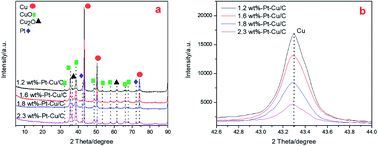Solar driven reduction of CO2 using Pt–Cu/C as a catalyst in a photoelectrochemical cell: experiment and mechanism study
Abstract
Carbon supported nano-metal catalysts are expected to improve CO2 reduction selectivity and efficiency due to the addition of more active sites and enhancement of electron transport ability. In this study, HKUST-1 was pyrolyzed and decorated with Pt to prepare Pt–Cu/C catalysts. The catalytic effect of the catalysts with different Pt contents in the CO2 photoeletrochemical reduction reaction (CO2PRR) were compared. The total carbon atom conversion rate in CO2PRR experiments using Pt–Cu/C catalysts first increased to a peak when using 1.6 wt% Pt–Cu/C catalyst and then decreased with the increase of Pt content. The 1.6 wt% Pt–Cu/C catalyst showed good hydrogen evolution reaction (HER) inhibiting ability compared with other Pt–Cu/C catalysts. Density functional theory (DFT) calculations were conducted to give an insight into the CO2PRR mechanism on some possible active sites in Pt–Cu/C catalysts. The result demonstrated that HER was more likely to be inhibited on the Cu/Pt active surface and at the same time CO2PRR was promoted.

- This article is part of the themed collection: Editors' collection: Carbon Dioxide Capture/Reduction


 Please wait while we load your content...
Please wait while we load your content...